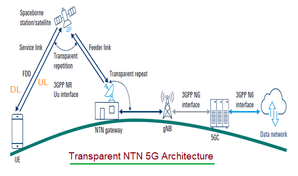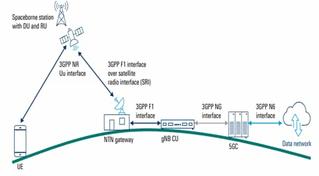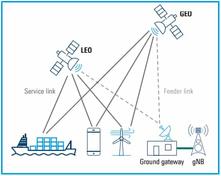5G NTN Protocol Stack: Transparent vs Regenerative Models
Advertisement
Introduction : Before we analyze 5G ntn (non-terrestrial network) related protocol stack, let us summarize TERRESTRIAL stack & functions of its layers.
Terrestrial protocol stack layers
Following are the standard functions of each of the layers used in terrestrial case.
- Physical (PHY) layer : Handles the actual transmission and reception of radio waves, including the waveform (OFDMA), modulation, coding, and reference signals for synchronization.
- Medium Access Control (MAC) layer : Manages real-time radio resource allocation. It is responsible for HARQ (error correction), scheduling requests (SR), buffer status reports (BSR), timing advance (TA), and the random access procedure (RACH).
- Radio Link Control (RLC) layer : Provides reliable data transfer. It segments data into smaller packets and ensures they are received correctly and in order (in Acknowledged Mode).
- Packet Data Convergence (PDCP) layer : Handles header compression, ciphering (encryption), and in-sequence delivery of packets to the upper layers.
- Service Data Adaptation Protocol (SDAP) layer : Maps the QoS Flows from the 5G Core network to the appropriate Data Radio Bearers.
- Radio Resource Control (RRC) & Non-Access Stratum (NAS) layer : RRC (Radio Resource Control) manages the radio connection, while NAS (Non-Access Stratum) manages the connection to the core network (mobility and session management).
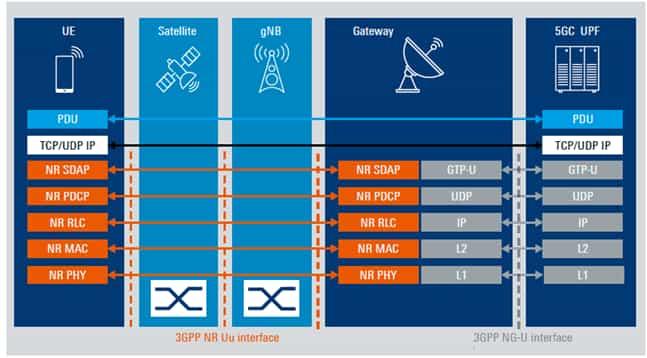 Figure:1 Transparent 5G NTN protocol stack layers (Image Courtesy : Rohde & Schwarz)
Figure:1 Transparent 5G NTN protocol stack layers (Image Courtesy : Rohde & Schwarz)
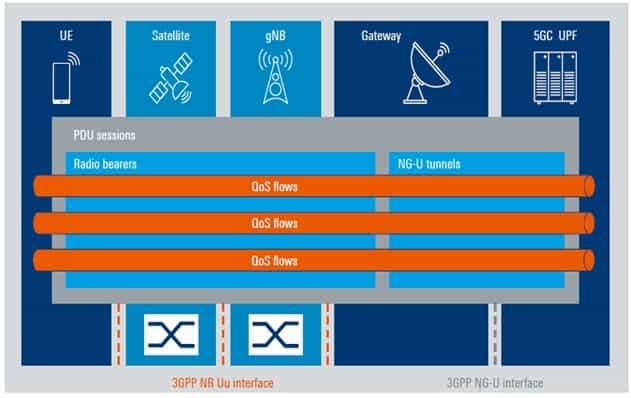 Figure:2 Transparent 5G NTN QoS & Bearer Model (Image Courtesy : Rohde & Schwarz)
Figure:2 Transparent 5G NTN QoS & Bearer Model (Image Courtesy : Rohde & Schwarz)
5G NTN (Non-Terrestrial Network) specific protocol stack
The main challenges driving the adaptations of protocol layers are due to following.
- Long and Variable RTT (Round-Trip Time): The massive propagation delay.
- Large Doppler Shift: The frequency distortion caused by high speed satellites.
- High Path Attenuation: The significant signal loss over long distances.
The main objective is to reuse existing 5G NR protocol stack with minimal changes, adapting it where necessary to handle the unique challenges of NTN.
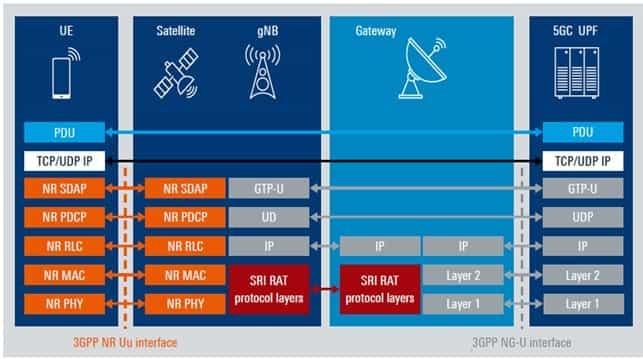 Figure:3 Regenerative 5G NTN protocol stack layers (Image Courtesy : Rohde & Schwarz)
Figure:3 Regenerative 5G NTN protocol stack layers (Image Courtesy : Rohde & Schwarz)
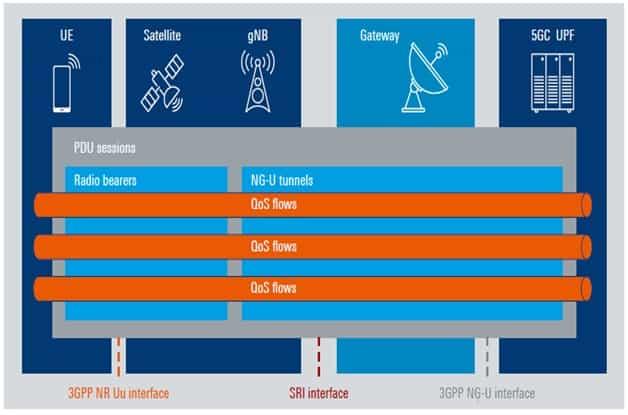 Figure:4 Regenerative 5G NTN QoS & Bearer Model (Image Courtesy : Rohde & Schwarz)
Figure:4 Regenerative 5G NTN QoS & Bearer Model (Image Courtesy : Rohde & Schwarz)
Following are the challenges in 5G NTN use case and NTN adaptations at each of the protocol stack layers.
- PHY layer
- Challenges : This layer is affected by doppler shift (distorts waveform), path loss (attenuates signal) and long delay (affects timing of packets).
- Adaptations :
- Timing : PHY procedures are designed to accommodate much larger “timing advance” value to handle long propagation delay.
- Polarization : Introduces circular polarization to mitigate faraday rotation effect & antenna misalignment.
- Doppler compensation : UE is required to pre-compensate for doppler shift (through frequency adjustment).
- Waveform : Standard 5G NR OFDMA waveform is used to provide compatibility with terrestrial 5G.
- MAC layer
- Challenges : This layer is the most heavily impacted by the long RTT, as its procedures are designed for very fast, real time feedback loops.
- Adaptations :
- HARQ (Hybrid ARQ): The standard HARQ process is too slow. The following enhancements are introduced:
- The number of parallel HARQ processes is increased from 16 to 32.
- The network can disable HARQ feedback, shifting the responsibility for reliable data delivery to the higher RLC layer.
- The network can configure automatic blind retransmissions without waiting for a NACK.
- Timing Advance (TA): The TA mechanism is enhanced with a two-part structure: a cell-wide common TA broadcast by the network, and a UE-specific TA calculated by the device to account for its precise position within the satellite’s beam.
- Random Access (RACH): The timers for the RACH procedure are extended. The ra-ResponseWindow and ra-ContentionResolutionTimer are made longer or have their start time deferred to prevent the UE from timing out while waiting for a response from the distant gNB.
- Scheduling Request (SR): The sr-ProhibitTimer, which prevents a UE from sending too many requests, has its maximum value extended beyond the standard 128 ms to accommodate the long grant-request cycle.
- HARQ (Hybrid ARQ): The standard HARQ process is too slow. The following enhancements are introduced:
- RLC layer
- Challenges : The timers related to reassembly and retransmission are too short for the long RTT.
- Adaptations :
- t-Reassembly Timer: This timer, which detects lost packets at the receiver, is significantly extended to up to 2200 ms to allow enough time for retransmissions to arrive.
- Reliability Shift: When MAC-level HARQ is disabled, the RLC Acknowledged Mode (AM) becomes the primary mechanism for ensuring reliable data delivery.
- PDCP layer
- Challenges : Similar to RLC, its timers for packet reordering and discarding are too short.
- Adaptations :
- discardTimer: This timer, which discards packets that have been waiting too long for transmission, is extended. A new discardTimerExt with a length of 2000 ms is introduced.
- Ciphering: The encryption function is unaffected by the introduction of NTN.
- SDAP layer
- Challenges : This layer is not sensitive to delay.
- Adaptations : No modifications are required for SDAP layer to support NTN.
- RRC and NAS Layers (Control Plane) :
- Challenges : hese layers need to be aware of the NTN context to provide the right information to the UE and to handle the long delays in signaling procedures.
- Adaptations :
- New System Information Block (SIB19): A new SIB is introduced to broadcast NTN-specific information, most importantly the satellite ephemeris data.
- New RAT Type: A new information element is signaled to the core network to indicate the UE is connected via NTN (e.g., NR-GEO). This informs the core network to use the appropriate extended timers and QoS profiles (like the 1100 ms delay budget).
- Timer Extensions: All relevant NAS timers for registration, session establishment, and service requests (e.g., T3510, T3517) are extended based on multiples of the Worst-Case Round-Trip Time (WCRTT).
**Summary:**The 5G NTN protocol stack maintains the same structure as its terrestrial counterpart but incorporates crucial flexibility, primarily through extended timers and new RRC/NAS parameters, to function effectively over long-delay satellite links.
Advertisement
 RF
RF